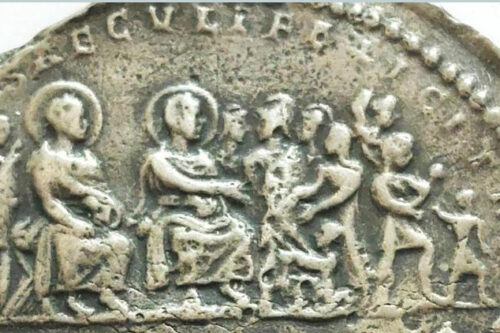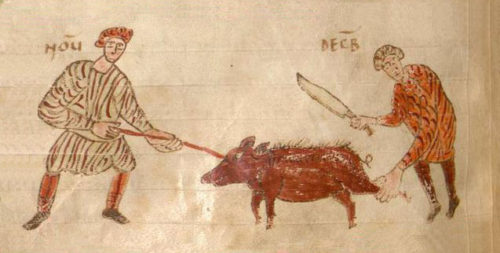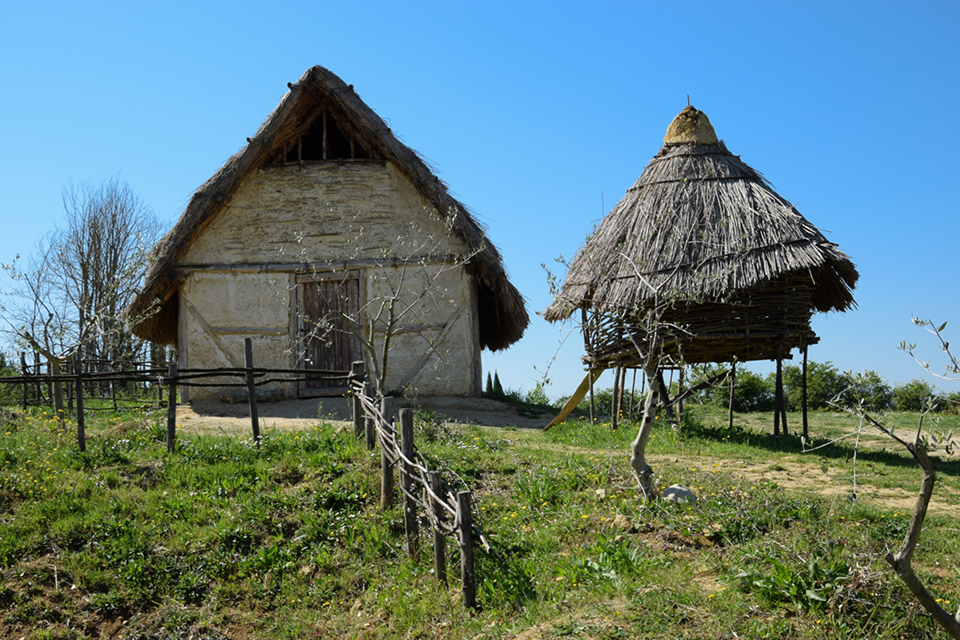How transformative were the shifts in the European countryside in the 5th to 7th centuries? To what extent did people resettle less than reuse old structures such as Roman villae? New book presents a series of important casestudies
The European Countryside during the Migration Period
Ed by Irene Bavuso and Angelo Castrorao Barba
De Gruyter 2023
The volume derives from a conference held at the University of Tübingen in 2029, called “Patterns of Change. The European Countryside during the Migration Period (300-700 CE)” as part of the work carried out by the DFG-Kolleg-Forschungsgruppe 2496: “Migration und Mobilität in Spätantike und Frühmittelalter”.
The geographical coverage of the volume ranges from Britain and the Atlantic Coast to Spain and across Europe to the Caucasus between 300 and 700 CE.

The opening chapter concerns the question of the accommodation of the Barbarians and confronts Goffart’s hypothesis from the 1980s, claiming that the Roman administration did not allocate the Barbarians’ land but rather allotments of farmed-out taxes. Once and for all, Ralph Mathiesen lays this old canard to rest, demonstrating the amount of “agri deserti” available to distribute. Essential are his calculations of the available land in Gaul, where the Goths settled, forging one of the first viable successor kingdoms in the first half of the 5th century. He notes the size of a typical barbarian lot of land, approximately 6,3 ha. A reasonable number of Goths would be 10.000, craving 63.000 ha or 630 km2. With Aquitaine covering more than 40.000 km2 and an estimated 7-10% of “agri deserti” in other Roman departments, a measly 630 km2 would not represent a challenge. Not even if the allotments had to be doubled up to furnish decent farmsteads for families to survive, the Roman administration would run dry.
Next up is a chapter analysing the statistics concerning the evolution of the post-villa landscape by Angelo Castrorao Barba concerning reoccupations, reuses, and reorganisations of the Roman villae in Italy. According to this study, the villa disappeared as a typical setting for the Roman economy and landscape between the late 5th and 6th centuries (ca 500 CE). Angelo Castroao Barba parallels this study in the valley of Duoro, while Philipp Heidegger reaches the same conclusion for Southern Germany and Tivadar Vida for Pannonia. The latter also demonstrates the dissolution of vici, demonstrating an apparent discontinuity. In the Caucasus, Dmitry Korobov outlines the contemporary formation of small fortified sites and tribal kingdoms consisting of 3-400 families.
A third group of papers focus on whether grave goods are indicative of ethnic or social status, questioning the governing standpoint that social status is at the forefront, while ethnic identification may not be deduced, even to specific items such as, for instance, the form of fibulae. Michel Kazanski and Anna Mastykova nonetheless propose that while men’s ornaments might primarily indicate status, female costumes were built around heirlooms, which were seldom traded as commodities. Thus, female burials are considered starting points for exploring social relations within both rural and urban contexts in the 6th century Crimea.
Following these reflections, a group of papers discuss the discrepancy between the sparse written evidence of the period and the archaeological contributions concerning the different social and economic reorganisations following in the footsteps of the migratory movements. With the availability of a new crop of studies analysing aDNA, we now know that the migration to Britain played out in several ways, depending on the character of the migratory movements – whether military, subsistence-driven or undertaken for “the betterment of life prospects”. Acknowledging the vast movements of people, these papers focus on the study of mobilities from a variety of perspectives.
Of particular interest is the study by Nicholas Schroeder concerning the mountainous landscapes of the Vosges and Jura with the different mental perceptions of the wilderness as either a resource or a spiritual and inaccessible desert. Opening up to a new framework for understanding the countryside in the Early Middle Ages, this evolves around investigations focusing on human-environment-ecology. Finally, this leads to a similar study of the Merovingian Northern Francia by Irene Bavuso between the 5th and the 8th centuries. As a vibrant borderland, the region was early on characterised by an elite engaged in trade and exchange transgressing the local region (as witnessed by the material culture excavated at central places at Uppåkra, Uppsala, Tissø, Lejre and elsewhere in Scandinavia).

Throughout the papers, the decisive role of the climate and the Justinian plague is debated. While the role of climate in the form of the Late Antique Little Ice Age (LALIA) is now less disputed than ten years ago, the impact of the Justinian Plague outside Byzantium is currently hotly contested. What were the consequences of the Bubonic plague, in view of the events in the 14th century, when more than 40% died in 1348-51, and social inequality grew as a function of the economic upheavals at that time? Thus, Pilar Diarte-Blasco argues “that the decrease in temperature and the increase in soil aridity influenced changes in the landscape of the Iberian Peninsula, including the development of extensive agriculture, deforestation, grazing, and transhumance”. On the other hand, other localities appear to have suffered or reacted in diverse ways. In this perspective, it is a pity the volume does not consider the very vibrant research currently carried out in Merovingian Norway, where the various consequences of a marked lowering in temperature – up to 3º C – have shown a variety of shifts in settlements and use of natural resources.
Thus, as is proper in the humanities at present, the introduction ends with a reflection “celebrating” the diversity of the different situations characterising the various geographical areas and research traditions. Nevertheless, “the contributions illuminate how different territories and societies underwent common transformations and distinctive changes, opening new avenues for appreciating the vitality of these areas during the Migration Period”, the introduction concludes.
So, what were the general shifts registered in the European countryside during the Migration period? Based on this collection of articles, we may conclude that:
- The old Roman villa economy deteriorated in Britain, gaul, Iberia, Italy, and further east.
- At the same time, the size of animals shrunk while people moved to the hillsides (whether for protection or to develop transhumance and agriculture of forestry (hazel, walnuts, and oak).
- A subsistence economy characterised this new landscape based on fewer cash crops (wheat) and a larger variety, including barley, rye and oats.
To what extent this development was forged in the climatic crucible of the LALIA, and furthered by the Justinian plague will need more research of the aDNA as well as sedeDNA, shedding better light on the actual timelodged transformation of the landscapes in question than palynology might come up with. One of the sites which may yield such new detailed insights might be the continued excavations in the Maremma in the valleys east of Elba. Or, alternatively, the continuing explorations of Early Medieval Poggibonsi
The book is highly recommended
Karen Schousboe
FEATURED PHOTO:
Photo from Early Medieval Open Air Museum at Poggibonsi © VisitTuscany/Claudia d’Aliasi
READ ALSO:
